Перевод и анализ слов искусственным интеллектом ChatGPT
На этой странице Вы можете получить подробный анализ слова или словосочетания, произведенный с помощью лучшей на сегодняшний день технологии искусственного интеллекта:
- как употребляется слово
- частота употребления
- используется оно чаще в устной или письменной речи
- варианты перевода слова
- примеры употребления (несколько фраз с переводом)
- этимология
Papal States - перевод на Английский
['peip(ə)l'steits]
синоним
['steitsəvðə'tʃə:tʃ]
история
Папская область
['kɔŋkleiv]
общая лексика
конклав
изолированная камера
существительное
общая лексика
тайное совещание
церковное выражение
конклав
коллегия кардиналов
синоним
Определение
Википедия
The Papal States ( PAY-pəl; Italian: Stato Pontificio; Latin: Dicio Pontificia), officially the State of the Church (Italian: Stato della Chiesa [ˈstaːto della ˈkjɛːza]; Latin: Status Ecclesiasticus), were a series of territories in the Italian Peninsula under the direct sovereign rule of the pope from 756 until 1870. They were among the major states of Italy from the 8th century until the unification of Italy, between 1859 and 1870.
The state had its origins in the rise of Christianity throughout Italy, and with it the rising influence of the Christian Church. By the mid-8th century, with the decline of the Byzantine Empire in Italy, the Papacy became effectively sovereign. Several Christian rulers, including the Frankish kings Charlemagne and Pepin the Short, further donated lands to be governed by the Church. During the Renaissance, the papal territory expanded greatly and the pope became one of Italy's most important secular rulers as well as the head of the Church. At their zenith, the Papal States covered most of the modern Italian regions of Lazio (which includes Rome), Marche, Umbria and Romagna, and portions of Emilia. These holdings were considered to be a manifestation of the temporal power of the pope, as opposed to his ecclesiastical primacy.
By 1861, much of the Papal States' territory had been conquered by the Kingdom of Italy. Only Lazio, including Rome, remained under the pope's temporal control. In 1870, the pope lost Lazio and Rome and had no physical territory at all, except St. Peter's Basilica and the papal residence and related buildings around the Vatican quarter of Rome, which the new Italian state did not occupy militarily, despite annexation of Lazio. In 1929 the Italian Fascist leader Benito Mussolini, the head of the Italian government, ended the "Prisoner in the Vatican" problem involving a unified Italy and the Holy See by negotiating the Lateran Treaty, signed by the two parties. This treaty recognized the sovereignty of the Holy See over a newly created international territorial entity, a city-state within Rome limited to a token territory which became the Vatican City.


.png?width=200)

![[[Papal Zouaves]] pose in 1869. [[Papal Zouaves]] pose in 1869.](https://commons.wikimedia.org/wiki/Special:FilePath/I fratelli de charette de la contrie detti i moschettieri del papa.jpg?width=200)
![The [[Quirinal Palace]], papal residence and home to the civil offices of the Papal States from the [[Renaissance]] until their annexation The [[Quirinal Palace]], papal residence and home to the civil offices of the Papal States from the [[Renaissance]] until their annexation](https://commons.wikimedia.org/wiki/Special:FilePath/Quirinale palazzo e obelisco con dioscuri Roma.jpg?width=200)


![2013 conclave]]. 2013 conclave]].](https://commons.wikimedia.org/wiki/Special:FilePath/Card. Mahony's Scrutiny Ballot, 2013.jpg?width=200)
![Since the [[conclave of 2005]], the cardinals electors reside in the [[Domus Sanctae Marthae]] for the length of the conclave Since the [[conclave of 2005]], the cardinals electors reside in the [[Domus Sanctae Marthae]] for the length of the conclave](https://commons.wikimedia.org/wiki/Special:FilePath/Domus Sanctae Marthae from the Dome of St. Peter's.jpg?width=200)
![Cardinals formerly used these intricate ballot papers, one of which is shown folded above. Currently, the [[ballot]]s are simple cards, folded once (like a note card), with the words "I elect as Supreme Pontiff" printed in Latin on them. Cardinals formerly used these intricate ballot papers, one of which is shown folded above. Currently, the [[ballot]]s are simple cards, folded once (like a note card), with the words "I elect as Supreme Pontiff" printed in Latin on them.](https://commons.wikimedia.org/wiki/Special:FilePath/Folded conclave ballot.jpg?width=200)
![White Smoke in Sistine Chapel, indicating that a pope has been elected by the [[College of Cardinals]].<ref name=Fumata-SmokeSignal /> White Smoke in Sistine Chapel, indicating that a pope has been elected by the [[College of Cardinals]].<ref name=Fumata-SmokeSignal />](https://commons.wikimedia.org/wiki/Special:FilePath/Fumo branco.jpg?width=200)

![Cardinals, bishops and priests attending the [[funeral of Pope John Paul II]] Cardinals, bishops and priests attending the [[funeral of Pope John Paul II]]](https://commons.wikimedia.org/wiki/Special:FilePath/John Paul II funeral long shot.jpg?width=200)
![conclave of 2013]], the newly elected [[Pope Francis]] appears for the first time to the crowd in St. Peter's Square conclave of 2013]], the newly elected [[Pope Francis]] appears for the first time to the crowd in St. Peter's Square](https://commons.wikimedia.org/wiki/Special:FilePath/Papa Francisco recién elegido.jpg?width=200)
